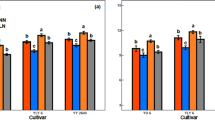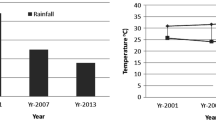Abstract
Background
Rising food demand, slowing productivity growth, poor N-use efficiency in rice, and environmental degradation necessitate the development of more productive, environmentally-sound crop and soil management practices. The system of rice intensification (SRI) has been proposed as a methodology to address these trends. However, it is not known how its modified crop-soil-water management practices affect efficiency of inorganic nitrogen applications.
Methods
Field experiments investigated the impacts of SRI management practices with different N-application rates on grain yield, root growth and activity, uptake of N and its use-efficiency, leaf chlorophyll content, leaf N-concentration, and photosynthetic rate in comparison with standard management practices for transplanted flooded rice (TFR).
Results
Overall, grain yield with SRI was 49 % higher than with TFR, with yield enhanced at every N application dose. N-uptake, use-efficiency, and partial factor productivity from applied N were significantly higher in SRI than TFR. Higher leaf nitrogen and chlorophyll contents during the ripening-stage in SRI plants reflected delayed leaf-senescence, extension of photosynthetic processes, and improved root-shoot activities contributing to increased grain yield.
Conclusions
Rice grown under SRI management used N fertilizer more efficiently due to profuse root development and improved physiological performance resulting in enhanced grain yield compared to traditional flooded rice.


Similar content being viewed by others
Abbreviations
- SRI:
-
System of rice intensification
- TFR:
-
Transplanted flooded rice
- AWD:
-
Alternate wetting and drying
- ANUE:
-
Agronomic nitrogen use efficiency
- PFP:
-
Partial factor productivity
- CP:
-
Cultivation practice
- MG:
-
Milk grain
- LR:
-
Late ripening
References
Aparicio V, Costa JL, Zamora M (2008) Nitrate leaching assessment in a long-term experiment under supplementary irrigation in humid Argentina. Agric Water Manag 95:1361–1372
Barison N, Uphoff N (2011) Rice yield and its relation to root growth and nutrient-use efficiency in SRI and conventional cultivation: an evaluation Madagascar. Paddy Water Environ 9:65–78
Cassman KG, Harwood RR (1995) The nature of agricultural systems: food security and environmental balance. Food Policy 20:439–454
Cassman KG, Peng S, Olk DC, Ladha JK, Reichardt W, Dobermann A, Singh U (1998) Opportunities for increased nitrogen-use efficiency from improved resource management in irrigated rice systems. Field Crops Res 56:7–39
Chapagain T, Yamaji E (2010) The effects of irrigation method, age of seedling and spacing on crop performance, productivity and water-wise rice production in Japan. Paddy Water Environ 8:81–90
DRD (2006) Rice varieties released/notified during 1996–2005. Directorate of Rice Development, Department of Agriculture and Co-operation, Ministry of Agriculture, Govt. of India, Patna
Fageria NK (2007) Yield physiology of rice. J Plant Nutr 30:843–879
George T, Ladha JK, Buresh RJ (1993) Nitrate dynamics during the aerobic soil phase in lowland rice-based cropping systems. Soil Sci Soc Am J 57:1526–1532
Gomez KA, Gomez AA (1984) Statistical procedure for agricultural research. Wiley, New York, p 680
Hiscox JD, Israelstam R (1979) A method of extraction of chlorophyll from leaf tissue without maceration. Can J Bot 57:1332–1334
ICAR (2006) Handbook of agriculture, 5th edn. Indian Council of Agriculture Research, New Delhi
Jiang L, Dai T, Jiang D, Cao W, Gan X, Wei S (2004) Characterizing physiological N-use efficiency as influenced by nitrogen management in three rice cultivars. Field Crops Res 88:239–250
Ju XT, Xing GX, Chen XP, Zhang SL, Zhang LJ, Liu XJ, Cui ZL, Yin B, Christie P, Zhu ZL, Zhang FS (2009) Reducing environmental risk by improving N management in intensive Chinese agricultural systems. Proc Natl Acad Sci U S A 106:3041–3046
Kassam A, Stoop W, Uphoff N (2011) Review of SRI modifications in rice crop and water management and research issues for making further improvements in agricultural and water productivity. Paddy Water Environ 9:163–180
Lin X, Zhou W, Zhu D, Zhang Y (2005) Effect of SWD irrigation on photosynthesis and grain yield of rice (Oryza sativa L.). Field Crops Res 94:67–75
Lin X, Zhou W, Zhu D, Chen H, Zhang Y (2006) Nitrogen accumulation, remobilization and partitioning in rice (Oryza sativa L.) under an improved irrigation practice. Field Crops Res 96:448–454
Menete MZL, van Es HM, Brito RML, DeGloria SD, Famba S (2008) Evaluation of system of rice intensification (SRI) component practices and their synergies on salt-affected soils. Field Crops Res 109:34–44
Naher UA, Othman R, Shamsuddin ZHJ, Saud HM, Ismail MR (2009) Growth enhancement and root colonization of rice seedlings by Rhizobium and Corynebacterium spp. Int J Agric Biol 11:586–590
Ookawa T, Naruoka Y, Sayama A, Hirasawa T (2004) Cytokinin effects on ribulose-1, 5-bisphosphate carboxylase/oxygenase and nitrogen partitioning in rice during ripening. Crop Sci 44:2107–2115
Osaki M, Shinano T, Matsumoto M, Zheng T, Tadano T (1997) A root-shoot interaction hypothesis for high productivity of field crops. Soil Sci Plant Nutr 43:1079–1084
Pasuquin E, Lafarge T, Tubana B (2008) Transplanting young seedlings in irrigated rice fields: early and high tiller production enhanced grain yield. Field Crops Res 105:141–155
Peng SB, Buresh RJ, Huang JL, Zhong XH, Zou YB, Yang JC, Yang GH, Liu YY, Tang QY, Cui KH, Zhang FS, Doberman A (2010) Improving nitrogen fertilization in rice by site-specific nutrient management: a review. Agron Sustain Dev 30:649–656
Samejima H, Kondo M, Ito O, Nozoe T, Shinano T, Osaki M (2004) Root-shoot interaction as a limiting factor of biomass productivity in new tropical rice lines. Soil Sci Plant Nutr 50:545–554
San-oh Y, Mano Y, Ookawa T, Hirasawa T (2004) Comparison of dry matter production and associated characteristics between direct-sown and transplanted rice plants in a submerged paddy field and relationships to planting patterns. Field Crops Res 87:43–58
San-oh Y, Sugiyama T, Yoshita D, Ookawa T, Hirasawa T (2006) The effect of planting pattern on the rate of photosynthesis and related processes during ripening in rice plants. Field Crops Res 96:113–124
Satyanarayana A, Thiyagarajan TM, Uphoff N (2007) Opportunities for water saving with higher yield from the system of rice intensification. Irrig Sci 25:99–115
Shindo J, Okamoto K, Kawashima H (2006) Prediction of the environmental effects of excess nitrogen caused by increasing food demand with rapid economic growth in eastern Asian countries, 1961–2020. Ecol Model 193:703–720
Sinha SK, Talati J (2007) Productivity impacts of the system of rice intensification (SRI): a case study in West Bengal, India. Agric Water Manag 87:55–60
Soejima H, Sugiyama T, Ishihara K (1995) Changes in the chlorophyll contents of leaves and in levels of cytokinins in root exudates during ripening of rice cultivars Nipponbare and Akenohoshi. Plant Cell Physiol 36:1105–1114
Stoop WA (2011) The scientific case for system of rice intensification and its relevance for sustainable crop intensification. Int J Agric Sustain 9:443–455
Stoop WA, Uphoff N, Kassam A (2002) A review of agricultural research issue raised by the System of Rice Intensification (SRI) from Madagascar: opportunities for improving system for resource poor farmers. Agric Syst 71:249–274
Stoop WA, Adam A, Kassam A (2009) Comparing rice production systems: a challenge for agronomic research and for the dissemination of knowledge-intensive farming practices. Agric Water Manag 96:1491–1501
Thakur AK, Uphoff N, Antony E (2010a) An assessment of physiological effects of system of rice intensification (SRI) practices compared with recommended rice cultivation practices in India. Exp Agric 46:77–98
Thakur AK, Rath S, Roychowdhury S, Uphoff N (2010b) Comparative performance of rice with system of rice intensification (SRI) and conventional management using different plant spacings. J Agron Crop Sci 196:146–159
Thakur AK, Rath S, Patil DU, Kumar A (2011) Effects on rice plant morphology and physiology of water and associated management practices of the system of rice intensification and their implications for crop performance. Paddy Water Environ 9:13–24
Tian YH, Bin Y, Yang LZ, Yin SX, Zhu ZL (2007) Nitrogen runoff and leaching losses during rice-wheat rotations in Taihu lake region, china. Pedosphere 17:445–456
Tong C, Hall CAS, Wang H (2003) Land use change in rice, wheat and maize production in China (1961–1998). Agric Ecosyst Environ 95:523–536
Uphoff N, Randriamiharisoa R (2002) Reducing water use in irrigated rice production with the Madagascar system of rice intensification (SRI). In: Bouman BAM (ed) Water-wise rice production. International Rice Research Institute, Los Banos, pp 151–166
Wang H, Inukai Y, Yamauchi A (2006) Root development and nutrient uptake. Crit Rev Plant Sci 25:279–301
Wang X, Suo Y, Feng Y, Shohag MJI, Gao J, Zhang Q, Xie S, Lin X (2011) Recovery of 15N-labeled urea and soil nitrogen dynamics as affected by irrigation management and nitrogen application rate in a double rice cropping system. Plant Soil 343:195–208
Xie JC (1998) Present situation and prospects for the world’s fertilizer use. Plant Nutr Fert Sci 4:321–330
Yang J, Zhang J (2010) Crop management techniques to enhance harvest index in rice. J Exp Bot 61:3177–3189
Yang C, Yang L, Yang Y, Ouyang Z (2004) Rice root growth and nutrient uptake as influenced by organic manure in continuously and alternately flooded paddy soils. Agric Water Manag 70:67–81
Yang X, Shang Q, Wu P, Liu J, Shen Q, Guo S, Xiong Z (2010) Methane emissions from double rice agriculture under long-term fertilizing systems in Hunan, China. Agric Ecosyst Environ 137:308–316
Zhang H, Xue Y, Wang Z, Yang J, Zhang J (2009) An alternate wetting and moderate soil drying regime improves root and shoot growth in rice. Crop Sci 49:2246–2260
Zhao LM, Wu LH, Li YS, Lu XH, Zhu DF, Uphoff N (2009) Influence of the system of rice intensification on rice yield and nitrogen and water use efficiency with different N application rates. Exp Agric 45:275–286
Zhao LM, Wu LH, Li YS, Animesh S, Zhu DF, Uphoff N (2010) Comparisons of yield, water use efficiency, and soil microbial biomass as affected by the system of rice intensification. Commun Soil Sci Plant Anal 41:1–12
Zhu ZL, Chen DL (2002) Nitrogen fertilizer use in China- contributions to food production, impacts on the environment and best management strategies. Nutr Cycl Agroecosyst 63:117–127
Acknowledgments
The authors wish to thank Prof. Norman Uphoff, Senior Advisor for the SRI International Network and Resources Center (SRI-Rice), Cornell International Institute for Food, Agriculture and Development, Ithaca, NY, USA, for reviewing drafts of this manuscript and offering useful comments. We also deeply thank the anonymous reviewers for their very constructive comments.
Author information
Authors and Affiliations
Corresponding author
Additional information
Responsible Editor: Matthias Wissuwa.
Rights and permissions
About this article
Cite this article
Thakur, A.K., Rath, S. & Mandal, K.G. Differential responses of system of rice intensification (SRI) and conventional flooded-rice management methods to applications of nitrogen fertilizer. Plant Soil 370, 59–71 (2013). https://doi.org/10.1007/s11104-013-1612-5
Received:
Accepted:
Published:
Issue Date:
DOI: https://doi.org/10.1007/s11104-013-1612-5




